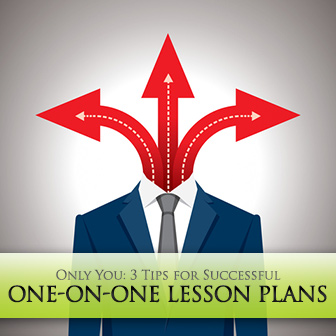Up Close and Personal: 5 Keys to Success for One-on-One Teaching


Follow these three tips for one-on-one lesson plans that will lead you to providing substantive classwork and endless possibilities.

When sitting down to write out one-on-one lessons plans, one of the most crucial aspects to consider is the amount of time you have and how you are going to make the most of it. It can be challenging to estimate time for a one-to-one class because if you are not carefully organized, your exercises may run too short. Since you don't have an entire group answering questions and participating in discussions, you have a lot more time to fill. Factoring this in when creating exercises will help you estimate more accurately. You can approximate that most activities will take about half as much time than with a group. It is absolutely necessary to alternate between grammar and other activities.
When teaching a one-to-one class keep your student engaged and interested throughout the entire lesson by alternating material and keeping your lesson going at a steady pace. Schedule your activities and exercises in increments of 10 to 15 minutes to help provide the necessary variety. You should always begin with a warm-up or icebreaker. These exercises at the beginning of the lesson could include light-hearted discussion topics, entertaining review topics, or games that are quick and easy to set up. You want to aim for anything that will get your student talking without apprehension. Icebreakers and warm-ups generally avoid structured grammar, and should be a nice lead in to what you are covering that day. You can sometimes stretch them out for more mileage with your one-to-one student.
Think about your lesson in terms of increments that you break up by focal point. Focus on specific grammar points that relate to each other so they can be weaved together. For example if you are working on telling time, do some exercises that bring in setting appointments or class schedules. Always show the student how they put the grammar or topic to use in daily life. Keeping this in mind, also write your lesson plan progressively, never starting out with the most difficult or newest material. Put new material toward the middle, so you sandwich the beginning and end with discussion and lively activities. A good gage is to vary activities every 15 minutes or so. You can allow up to 20 minutes for the main activity of your lesson plan or for the teaching of an entirely new grammar point. Planning in discussion time adds a lot of substance to one-on-one lessons, and you can practice grammar points, topics, and listening in very natural ways, simply by communicating together. Devising ways of getting students to talk without fear or judgement also plays a role in your lesson planning. Include role-plays, guessing games, and real-world examples to make your lesson even more varied.
To save time lesson planning, it is beneficial to prepare many different types of conversation and writing prompts. Doing this in advance can save you time, and give you plenty of options for filling extra time, moving in a different direction, and catering topics to your individual student. You may want to make lists of each type of prompt separately, those best for speaking and the most interesting for writing. However that doesn't mean that you can't combine them or switch them up. If you did some speaking exercises around the family tree, you could then present some writing prompts that are specific to the student's family. Conversation and writing topics can go well together because they reinforce one another. Choose prompts that are substantive, unique and align with student's interests and passions. Use jumping off points like cultural celebrations, news, pop culture, or anything else the student may be fascinated to write about or discuss. Also, remember to tap into the student's culture to create a lot of wonderful and personal dialogues. Your student may also be very interested in hearing about how your culture operates, as well as the nuances of English that you know so intimately. Make personal connections and if you want to take it to the next level, incorporate journal-keeping into the mix for some fixed amount of free writing.
It is important to have a timeline for your lesson planning. To do your student the best service possible, you need to have a vision of long-term goals for the student and your time together. This can easily be done by involving the student and creating goals as a team. It is advantageous for the student to go through goal-setting exercises, and to receive your input. Offer your suggestions and also your expertise to the student. It should be apparent to your student that you will help them achieve their goals, but that you also have expectations. Those expectations should ultimately help them achieve relevant milestones.
Give a lot of consideration to how you will make certain your student succeeds. Once you are clear what the focal points are for the student's development, it is time to decide what approach you are going to take. How will you incorporate developing the four skill, and honing in on the two that are most crucial to your student? What types of reading and listening materials do you think would work for this student? How do you plan to approach grammar each lesson, and then what types of reinforcement will you do? Your approach must be systematic in that you know ahead of time where you are heading. Examining the future will help you to stay in the present and make decisions based on long-term goals and short-term gains.
Use the above tips to create lesson plans that are full of possibilities, variety, and thoughtful goals.